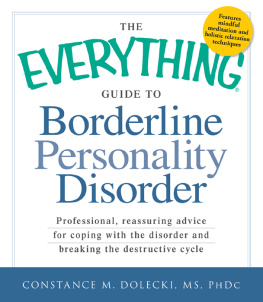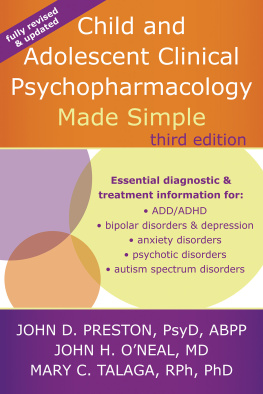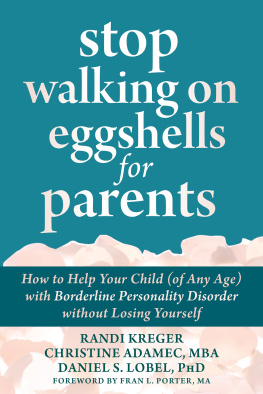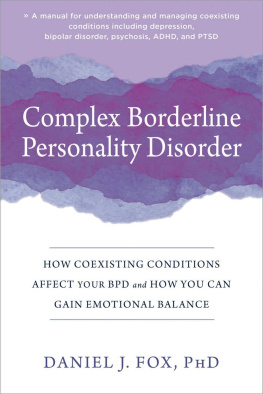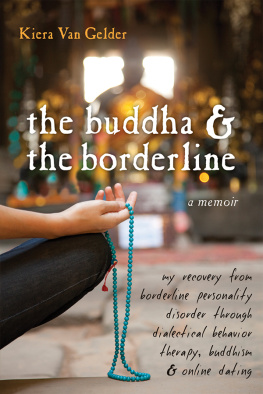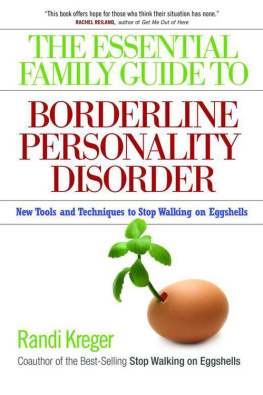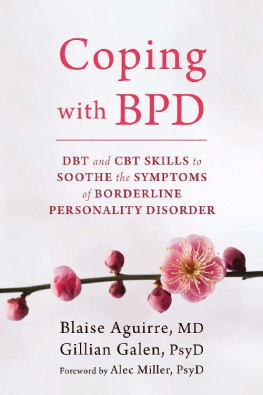Borderline Personality Disorder in Adolescents
Borderline Personality Disorder in Adolescents
A COMPLETE GUIDE TO UNDERSTANDING AND COPING WHEN YOUR ADOLESCENT HAS BPD
Blaise A. Aguirre, M.D.

Text 2007 Blaise A. Aguirre
First published in the USA in 2007 by
Fair Winds Press, a member of
Quayside Publishing Group
100 Cummings Center
Suite 406-L
Beverly, Massachusetts 019156101
www.fairwindspress.com
All rights reserved. No part of this book may be reproduced or utilized, in any form or by any means, electronic or mechanical, without prior permission in writing from the publisher.
11 10 09 08 07 1 2 3 4 5
Digital edition: 978-1-61673-429-9
Hardcover edition: 978-1-59233-287-8
ISBN-10: 1-59233-287-0
Library of Congress Cataloging-in-Publication Data
Aguirre, Blaise A.
Borderline personality disorder in adolescence : a complete guide to understanding and coping when your adolescent has BPD / Blaise A. Aguirre.
p. cm.
Includes bibliographical references and index.
ISBN 1-59233-287-0
1. Borderline personality disorder in adolescencePopular works. 2. Adolescent psychotherapyPopular works. I. Title.
RJ506.B65A38 2007
616.85852dc22 2007024656
Book design by Dutton & Sherman Design
Printed and bound in USA
The information in this book is for educational purposes only. It is not intended to replace the advice of a physician or medical practitioner. Please see your health care provider before beginning any new health program.
The names and circumstances of certain individuals in this book have been changed to protect their identities.
To my kids Isabel, Anthony, Lucas, and Gabrielplease always let me know when I dont get it. And for Lauren, who always lets me know when I dont get it!
CONTENTS
FOREWORD
THE DIAGNOSIS OF borderline personality disorder in adolescents has a status not unlike that it held for adults 30 years agoit is widely used by clinicians but lacks the scientific base that entry into the official nosological system requires.
Still, the diagnosis is widely used for adolescents even without such official recognition because clinically experienced adolescent psychiatrists, like their adult psychiatric predecessors, recognize the distinctive problems these patients present: their need for attention, their desperate fears of abandonment, their inappropriate anger and vilification of those who disappoint them, and their suicidal risk when alone.
These patients magnify our own least desirable traits of being too angry or too needy. They are too much like we fear ourselves to be. No other patient group is so easyand so uncomfortableto identify with. They leave us all with a conflicttheir neediness pulls us to rescue, their anger pushes us to withdraw.
Dr. Blaise Aguirre captures all of this and more. He writes with the sure hand of a clinician who knows his subject from having been personally immersed in it for all of his professional life. His vignettes are instructive and vivid. They evoke the impulse to rush toward or run away from these troubled adolescents. His writing is lucid and engaging, entertaining and educational. This book provides an excellent manual for patients, families, and clinicians. It helps us understand and sympathize with borderline adolescents. It will probably motivate everyone to remainor becomeinvolved with this desperately needy and usually alienated subset of our population.
The clinical wisdom necessary for their successful treatment is exemplified in this book. That such clinical wisdom exists and is so necessary is in itself a compelling rationale for why the borderline diagnosis should become official for adolescents.
John G. Gunderson, M.D.
Professor of Psychiatry, Harvard Medical School
Director, Treatment and Research Center for Borderline Personality
Disorders, McLean Hospital
INTRODUCTION
RECENTLY, MY COLLEAGUES AND I had a family meeting with a teenage girl from Connecticut and her parents. She had been admitted to McLean Hospital for treatment of bipolar disorder even though she had all the classic symptoms of borderline personality disorder (BPD): fears of abandonment and emptiness, self-injury, overidealizing and later devaluing her boyfriend, suicidal thoughts, reactive mood swings, and impulsivity.
The girls parents wondered why she wasnt getting any better despite all the medication she had been on. We reviewed her symptoms and pointed out that she met criteria for BPD but not bipolar disorder. The father, a prominent psychiatrist who worked with adult patients, became very upset and asked for a meeting without his daughter.
How, he asked after she left the room, can you make the diagnosis of BPD in a child? Giving her that diagnosis means years of misery and hopelessness for her and for us. You forget I am a psychiatrist. I know borderlines. Theyre impossible!
Years ago, I would have agreed with this father. Years ago, I myself saw firsthand the devastating suffering of a close friend who struggled with the disorder. I was a medical student at the time, and though I tried to find help for her, there was little useful treatment or understanding of BPD. My friend found no peace or hope that she would ever get better. Like many others who have relationships with people who suffer from this disorder, I found I didnt have the strength to maintain our relationship, and we fell out of touch. But my friends intense suffering made a lasting impression. Despiteor perhaps even because ofmy inability to help her I developed a profound interest in this difficult and little-understood disorder.
A decade and a half later, in May 2000, I joined the staff at McLean Hospital, the largest psychiatric affiliate of Harvard Medical School, to work on its thirty-bed, adolescent residential psychiatric unit. I soon discovered that there was great disinclination to make the diagnosis of BPD in adolescents for fear that it would label these teens with one of the most feared, stigmatizing, and difficult-to-treat disorders in psychiatry. To make matters worse, of all the conditions in psychiatry, BPD has one of the highest suicide rates, with up to 10 percent of patients committing suicide.
From the beginning, I felt an ethical obligation to diagnose adolescents with BPD when appropriate, regardless of the early reluctance of some colleagues.
Despite being cautioned against making the diagnosis of BPD, I found that, for the most part, neither the patients nor their parents shied away from the diagnosis. The stigma of BPD was the clinicians issue, not the patients. In fact, the more parents read about BPD in adults, the more it seemed to fit the clinical picture of their children. Parents were frustrated, however, that there was so little information on the condition in adolescents, and they often ask for something to read on adolescent BPD. Sadly, there was scant literature, despite the fact that many of the adolescents who come through psychiatric hospitals like McLean have BPD or traits of BPD. Furthermore, I was frustrated that our early attempts at treatment in adolescents did not appear to reduce their misery. No amount of medication or talk therapy seemed to help. But soon after my arrival at McLean, some of our clinicians started to practice a form of treatment known as dialectical behavioral therapy (DBT), and these sometimes highly self-destructive adolescents would dramatically reduce their self-destructiveness.
Next page

